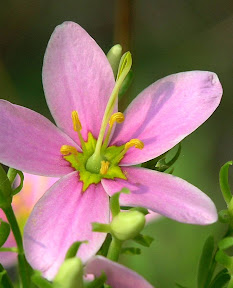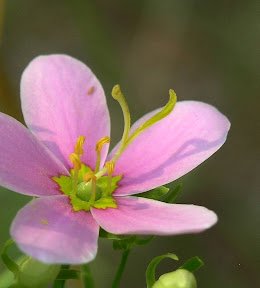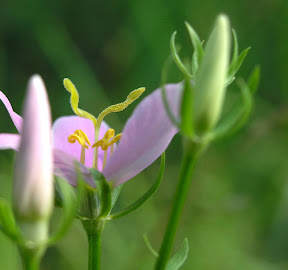I learned a new vocabulary word today: Protandrous. According to Dictionary.com protandrous means "Of or relating to a flower in which the anthers release their pollen before the stigma of the same flower is receptive." It is a strategy by which a complete flower -- one having both male and female parts -- prevents or limits self-pollinization and helps ensure the exchange of genetic information with another member of the same species. Rosepink (Sabatia angularis) is an example of a protandrous flower.


When the rosepink flower first opens the five stamens (male) stand erect their anthers are heavily laden with pollen. However, the style (female) lays flat against the petals and its two branches are twisted together concealing their stigmatic lines. Any pollinators visiting the flower -- usually short-tongued bees -- are likely to receive a dusting of pollen from the anthers, but highly unlikely to deposit any of that pollen on the style and fertilize the flower.

After a few days when the anthers' pollen supply is significantly reduced, the style begins to stiffen and stand erect.

The two branches of the style also untwist exposing their pollen receptive stigmatic lines.

Eventually the two branches of the style are spread out across the top of the flower. Pollen dusted insects don't know that this flower's supply of pollen is depleted. As they enter the flower and probe about looking for pollen, they accidentally dust the stigmas and fertilizer the flower.
Rosepink is a native annual that blooms mid-summer in most of the central and eastern United States except for the far northeast. (USDA distribution map)
Missouri Flora has an excellent photo showing the entire plant.
Now all I have to figure out is how to work my new vocabulary word into casual conversation before I forget it.



13 comments:
You have to give it high marks for being pretty.
GORGEOUS pictures! Though I truly appreciate and like all the bugs, this is a very nice break, and pink to boot!
I learned a new word, too, and I'm sure I'll forget it before I can work it into a conversation, but I'm going to write it down and give it a shot!
Simply amazing how a flower could figure all of that out -- "calling Charles Darwin"...
Apart from the great pictures, this makes great reading .. love the Buckeye below, and the Black-waved Flannel Moth caterpillar below that, and the Black-waved Flannel Moth it self... nearly forgot.. that the The Leafhopper was of great interest to.. :O)
What I meant to say Marvin is that it as been great catching up on everything you have posted about since my last visit... :O)
wo... got my bit of learning for the day, thx marvin :)
Nice biology lesson Marv. I will be interested in reading the sentence you use your new word in.
Lovely! Just lovely.
To me, that's the most important thing. :-) The interesting facts are neat, but...... It's just lovely!!!
July 22... A little bird told me that I would like to wish you a Very Happy, Happy, Happy... Day!!! :-)
Not wanting to throw the "little bird" completely "in," I'll leave it at that. I think.........
But there are still 7 hours left in the day, to come back, and elaborate. :-)
Miss Mari-Nanci
My word your photography is amazing. the colors, the clarity and the framing is absolutely perfect. I was stunned and then I started to scroll down and saw the moth, but I quickly scrolled back up and decided to take them one at a time. :) Although it was hard!!! :) :)
Happy Birthday, Marvin!
I'm playing catch-up on the last few posts (back to the Tersa Sphinx). Amazing photos, as usual. The irritating hairs on the Black-waved Flannel Moth caterpiller remind me of a jellyfish, somehow; the ones with stinging tentacles.
Visiting your blog is like taking a very interesting Biology class. Thanks!
Great post.
I learned a new word today also, thanks to you.
It's alway fun and educational to visit here, even though I don't always stop to comment.
Nice Buckeye.
Thanks for the visit,
Troy
Great word, flowers and post! Just great all around!
A man after my own heart I see. :) I love taking pictures of the smaller creatures too. You have wonderful pictures on you blog Marvin. Thanks for sharing.
what a delicate flower! a joy to the eye!
Post a Comment